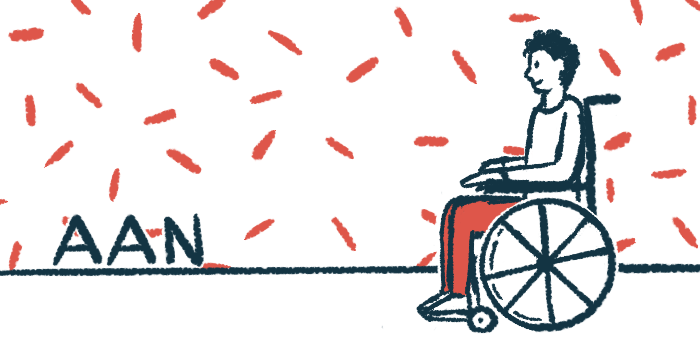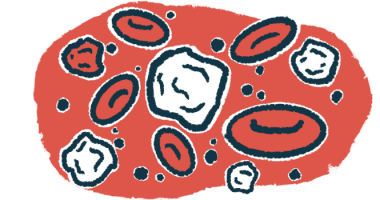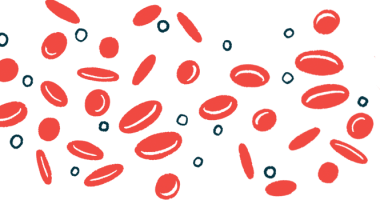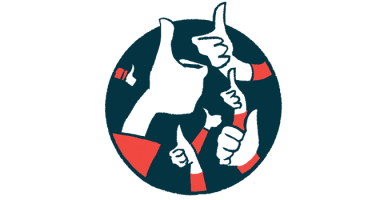AAN 2023: Enspryng still safe, effective after 4.5 years in trials
Findings came from Phase 3 SAkuraSky, SAkuraStar, and SAkuraMoon studies

Up to 4.6 years of treatment with Enspryng (satralizumab) continues to safely reduce relapse rates and prevent disability progression for people with neuromyelitis optica spectrum disorder (NMOSD) who are positive for antibodies against aquaporin-4 (AQP4).
That’s according to pooled data from the Phase 3 SAkuraSky (NCT02028884) and SAkuraStar (NCT02073279) trials and its open-label extension study, SAkuraMoon (NCT04660539). The findings were discussed in two presentations at the American Academy of Neurology (AAN) 2023 annual meeting last month in Boston and virtually.
Developed by Roche subsidiary Chugai Pharmaceutical, Enspryng is an antibody-based therapy that targets the interleukin-6 receptor, an important protein for driving inflammation in NMOSD.
Administered under the skin every four weeks, it’s approved in several countries for preventing attacks in NMOSD patients positive for anti-AQP4 antibodies, the most common type of NMOSD-causing antibodies.
The approvals were based on data from the placebo-controlled part of the pivotal Phase 3 SAkuraSky and SAkuraStar trials of 178 adults and adolescents with NMOSD.
Results showed 120 mg of Enspryng was superior to a placebo at safely lowering the risk of relapses for up to nearly two years when used alone or combined with usual immunosuppressive therapies.
After completing this part of either trial, participants entered the respective extension portions, wherein all received the therapy for an additional two years. Pooled data from up to 4.4 years showed its efficacy persisted over time, with most patients remaining free from relapses and sustained disability worsening.
Preliminary SAkuraMoon findings
Those who completed both the placebo-controlled and extension portions of either trial were rolled into the extension SAkuraMoon study, where they are receiving Enspryng (120 mg) for up to three years. The participants may receive the therapy with or without standard immunosuppressive treatments.
SAkuraMoon’s preliminary efficacy findings were shared by Anthony Traboulsee, MD in the talk, “Long-term Efficacy of Satralizumab in Adults with Aquaporin-4-IgG-seropositive (AQP4-IgG+) Neuromyelitis Optica Spectrum Disorder (NMOSD): Results from SAkuraMoon.” Traboulsee, who was involved in the trial, is a professor and research chair of the Multiple Sclerosis Society of Canada at the University of British Columbia.
The analysis concerned 106 adult patients (mean age 44; range 20-73) who were positive for anti-AQP4 antibodies and received at least one dose of Enspryng during these studies as of Jan. 31, 2022, the data cutoff date.
Their mean age was 44 (range 20-73) and most were women (89.6%). Across the SAkura trials, the participants had been exposed to Enspryng for a median of five years (one month to nearly eight years).
The patients’ average annualized relapse rate was 0.09, which remained relatively stable with additional years of treatment, results showed. Specifically, patients had an average of 0.16 relapses per year after one year, 0.1 at two years, 0.05 at three years, and 0.07 at four years.
After up to 240 weeks, or about 4.6 years, 72% of patients remained relapse-free and 91% were free from severe relapses. It “was very impressive” to see that “less than 10% of patients had a severe relapse,” Traboulsee said, noting those who did have relapses had “good recovery” with steroids, in general.
Moreover, 85% of patients over nearly five years were free from sustained disability worsening or an increase in scores on the Expanded Disability Status Scale (EDSS) that was confirmed at least six months later.
The findings highlighted that the annualized relapse rate remained consistently low, corresponding to about “one relapse every 10 years,” Traboulsee said, adding “very few patients were having severe relapses … and a low number of patients [had] sustained change in their EDSS [score] over to close to five years of follow-up.”
Interim SAkuraMoon findings
Interim safety findings from SAkuraMoon were discussed in the poster “Long-term Safety of Satralizumab in Adults with Aquaporin-4-IgG-seropositive (AQP4-IgG+) Neuromyelitis Optica Spectrum Disorder (NMOSD): Results from SAkuraMoon.”
No new safety findings were detected with longer Enspryng treatment, up to nearly eight years, among the 106 patients.
Rates of adverse events and serious adverse events over the long term were comparable to those observed during the initial placebo-controlled portions of SAkuraSky or SAkuraStar.
Rates of infections and serious infections were also similar to those reported during the studies’ placebo-controlled phases, with no increase observed over time, even among those also on immunosuppressive therapies. The most commonly reported infections were in the upper respiratory tract and the urinary tract.
There were no deaths nor allergic reactions related to the therapy and no injection-related reactions led to it being interrupted or discontinued.
“Longer exposure to [Enspryng] was not associated with a higher risk of severe laboratory changes versus the [placebo-controlled] periods,” the researchers wrote. “These results demonstrate that the safety of [Enspryng with or without immunosuppressive therapy] observed in the [placebo-controlled portions] is sustained with long-term treatment over a median treatment exposure of 5 years.”
Enspryng is also being evaluated in other NMOSD patient populations.
The international Phase 4 SAkuraBONSAI trial (NCT05269667) is testing the therapy in newly diagnosed patients and others who couldn’t or didn’t participate in the Phase 3 trials. Participants are being recruited in the U.S., Europe, and Asia.
A Phase 3 trial, dubbed SAkuraSun (NCT05199688), is assessing the therapy’s safety and efficacy in children, ages 2-11, with NMOSD and anti-AQP4 antibodies. The study is still enrolling up to eight participants in the U.K., France, and Poland.







